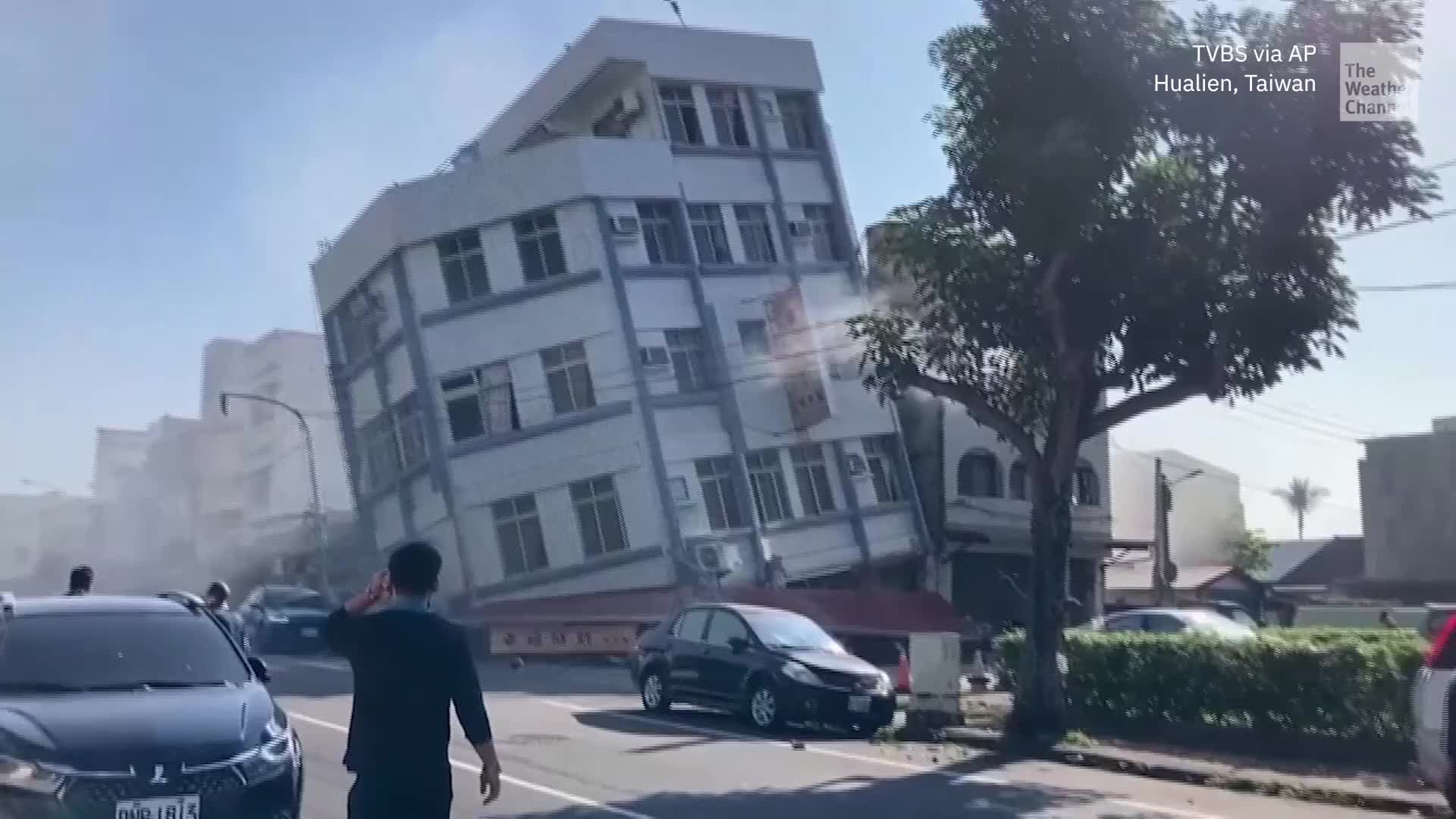Taiwan Earthquake

Taiwan Earthquake News: Breaking news on Wednesday, April 3rd, 2024, reports a powerful earthquake striking Taiwan. The tremor, measuring 7.2 on the Richter scale, sent shockwaves through the island nation. This blog provides the latest updates on the Taiwan earthquake, including damage reports, tsunami warnings, and regional impact.
Taiwan Earthquake: Tremors Felt Across the Region
The earthquake struck off Taiwan’s eastern coast at approximately 7:58 AM local time. The tremor was strong enough to be felt in the capital, Taipei, and as far south as Japan and the Philippines. Buildings swayed, furniture toppled, and panicked residents rushed into the streets.
Taiwan Earthquake Damage:
Reports indicate damage to buildings and infrastructure across eastern Taiwan. Authorities are still assessing the full extent of the damage, but initial reports mention collapsed buildings, cracked roads, and power outages. Rescue teams are on the scene, searching for survivors and assisting those trapped in the aftermath.
Taiwan Tsunami Warning Issued:
Following the earthquake, authorities issued a Taiwan tsunami warning. Coastal residents were urged to evacuate to higher ground as a precautionary measure. Thankfully, the tsunami threat appears to have subsided. Japan and the Philippines also issued precautionary tsunami warnings, which were later lifted.
Taiwan Earthquake and Japan:
The tremor was felt across southern Japan, particularly in the Okinawa prefecture. Minor shaking and disruptions were reported, but no significant damage or injuries have been documented.
Taiwan Earthquake and the Philippines:
The northern Philippines, particularly the Batanes and Cagayan provinces, experienced tremors from the earthquake. Authorities issued a brief tsunami warning, which was later lifted. No major damage or casualties have been reported from the Philippines.
Taiwan Earthquake Relief Efforts:
Emergency services in Taiwan are working tirelessly to assess the damage, locate survivors, and provide medical assistance. International aid agencies are also preparing to offer support in the coming days.

Stay Informed About the Taiwan Earthquake:
The situation in Taiwan remains fluid. This blog will be updated with the latest Taiwan earthquake news as it becomes available. Here are some reliable sources for further information:
- Central Weather Bureau of Taiwan (https://www.cwa.gov.tw/eng/)
- Taiwan News (https://www.taiwannews.com.tw/)
- BBC News (https://www.bbc.com/)
- CNN International (https://edition.cnn.com/?refresh=1)
Social media platforms can also offer real-time updates on the situation in Taiwan. However, it’s crucial to rely on trusted news sources to avoid misinformation.
Taiwan Earthquake: A Time for Solidarity
The Taiwan earthquake serves as a stark reminder of the power of nature. Our thoughts and prayers are with the people of Taiwan during this difficult time. The international community stands ready to offer support and assistance in the recovery efforts.
The Unfolding Story: Updates on the Taiwan Earthquake
Following the initial tremors on April 3rd, 2024, the world watched anxiously as the situation in Taiwan unfolded. This section provides a deeper look at the ongoing developments:
Aftershocks and Continued Anxiety:
Taiwan is no stranger to earthquakes, but the intensity of this tremor has heightened anxieties. Numerous aftershocks have rattled the region, causing further distress and hampering recovery efforts.
Assessing the Damage:
The full extent of the damage remains unclear. Rescue teams meticulously comb through affected areas, searching for survivors and securing compromised structures. Initial reports indicate damage concentrated in eastern Taiwan, particularly Hualien City.
Infrastructure Concerns:
Cracks and damage have been identified in roads, bridges, and other critical infrastructure elements. This raises concerns about transportation disruptions and potential long-term impact on the island’s economic activity.
Power Outages and Communication Disruptions:
The earthquake caused widespread power outages, plunging many areas into darkness. Communication networks also suffered disruptions, hindering information flow and hampering emergency response efforts. Restoration efforts are underway, but it might take time to fully re-establish connectivity.
Human Cost of the Earthquake:
Sadly, the earthquake has claimed lives and caused injuries. While official figures are still emerging, reports indicate casualties concentrated in areas with collapsed buildings. Emotional trauma is another significant concern, with many grappling with the fear and uncertainty of the event.
Taiwan’s Resilience:
Despite the devastation, Taiwan’s government and its people are known for their resilience. Emergency services are working tirelessly to provide aid and support to those in need. The spirit of community and cooperation is evident as residents come together to help each other.
International Support Pours In:
The international community has responded swiftly with offers of support. Rescue teams, medical aid, and financial assistance are being mobilized from various countries to assist Taiwan in its recovery efforts.
Taiwan Earthquake and Japan:
While Japan felt tremors from the earthquake, the impact seems relatively minor. However, the event serves as a reminder of the region’s vulnerability to seismic activity. Both Japan and Taiwan have extensive experience with earthquake preparedness and mitigation strategies, which likely helped minimize damage in this instance.
Taiwan Earthquake and the Philippines:
Similar to Japan, the Philippines experienced minor tremors. This earthquake highlights the importance of regional cooperation on disaster preparedness and risk reduction strategies.
Lessons Learned from the Taiwan Earthquake:
The Taiwan earthquake serves as a stark reminder of the importance of earthquake preparedness. Robust building codes, regular disaster drills, and readily available emergency supplies can significantly impact the outcome of such events.
Looking Ahead: Rebuilding and Recovery
The road to recovery for Taiwan will be long and arduous. Rebuilding infrastructure, supporting affected communities, and providing mental health services are just some of the essential steps in the process. The international community can play a vital role by offering resources and expertise to assist Taiwan in its recovery efforts.
How You Can Help:
Individuals can also contribute to the relief efforts in several ways:
- Donate to reputable organizations providing aid to Taiwan.
- Spread awareness about the situation through social media channels.
- Offer words of solidarity and support to the people of Taiwan.
The Taiwan earthquake is a powerful reminder of nature’s unpredictable power. However, it also showcases the strength of human resilience and the importance of international cooperation in times of crisis. As Taiwan navigates this challenging period, the world stands together in support of its recovery efforts.
Living on the Edge: Why Taiwan, Japan, and the Philippines are Earthquake Prone
The recent powerful Taiwan earthquake serves as a stark reminder of the seismic activity that constantly shapes the Asia-Pacific region. Countries like Taiwan, Japan, and the Philippines experience frequent tremors, raising the question: Why are Taiwan, Japan, and the Philippines so prone to earthquakes? Understanding the geological forces at play helps us predict, prepare for, and mitigate the impact of these events.
A Fiery Underworld: Tectonic Plates and Seismic Activity
Our planet’s crust isn’t a single, solid piece. Instead, it’s broken into giant, constantly moving slabs called tectonic plates. These plates grind, slide, and collide with each other, creating immense pressure and friction. Earthquakes occur when this pressure builds up and is suddenly released, sending shockwaves through the Earth’s crust.
The Ring of Fire: A Seismic Hotspot
Taiwan, Japan, and the Philippines all reside along a particularly active seismic zone known as the Pacific Ring of Fire. This horseshoe-shaped belt encircles the Pacific Ocean and is home to roughly 75% of the world’s active volcanoes and a significant portion of its earthquakes.
Subduction Zones: Where Plates Collide
The Pacific Ring of Fire owes its intense seismic activity to a geological phenomenon called subduction. Here’s where it gets interesting:
- Imagine a giant oceanic plate like the Pacific Plate slamming into a lighter continental plate like the Eurasian Plate.
- The denser oceanic plate gets forced beneath the lighter continental plate, a process known as subduction.
- As the oceanic plate descends, it melts due to the intense heat and pressure within the Earth’s mantle.
- This molten rock, or magma, rises towards the surface, sometimes erupting as volcanoes.
- The subducting plate also scrapes against the overriding plate, causing immense friction and pressure buildup.
The Release: Triggering Earthquakes
The friction and pressure from the subduction zone eventually reach a breaking point. When this happens, the accumulated energy releases suddenly, causing the Earth’s crust to vibrate – an earthquake.
Taiwan’s Seismic Story
Taiwan sits right where the Philippine Sea Plate collides with the Eurasian Plate. This ongoing subduction process creates the Ryukyu Trench, a deep underwater canyon east of Taiwan. The subduction zone is responsible for the frequent tremors experienced in Taiwan, including the recent powerful earthquake.
Japan’s Seismic Saga
Japan is another island nation situated along the Pacific Ring of Fire. Here, several tectonic plates converge – the Pacific Plate, the Philippine Sea Plate, the Eurasian Plate, and the North American Plate. These complex interactions create numerous subduction zones around Japan, making it one of the most earthquake-prone countries globally.
The Philippines in the Seismic Spotlight
The Philippines also lies within the Pacific Ring of Fire. The subduction of the Philippine Sea Plate beneath the Eurasian Plate forms the Manila Trench east of the Philippines. Additionally, the Philippine Fault System, a complex network of faults running through the archipelago, contributes to the nation’s vulnerability to earthquakes.
Beyond Subduction: Additional Seismic Factors
While subduction zones are the primary cause of earthquakes in Taiwan, Japan, and the Philippines, other factors can influence seismic activity:
- Fault Lines: These are cracks in the Earth’s crust where movement can occur. Movement along these faults can trigger earthquakes.
- Volcanic Activity: As mentioned earlier, subduction zones often lead to volcanic activity. Volcanic eruptions can sometimes trigger earthquakes, further increasing seismic risk.
- Landforms: The shape and composition of the land can amplify or dampen earthquake effects.
Living with Seismic Activity: The Importance of Preparedness
Taiwan, Japan, and the Philippines have a long history of dealing with earthquakes. These countries have implemented robust building codes, conduct regular earthquake drills, and maintain well-equipped emergency response systems.
Continuous monitoring of seismic activity is crucial for early warnings and evacuation procedures. Additionally, public education plays a vital role in ensuring widespread awareness and preparedness among residents.
The Future of Earthquake Prediction and Mitigation
While predicting earthquakes with pinpoint accuracy remains a challenge, scientists are constantly working on improving earthquake prediction models. Early Warning Systems (EWS) can offer crucial seconds or even minutes before a major tremor strikes, allowing for evacuation and potentially saving lives.
Earthquake-resistant building designs and advanced engineering solutions can also significantly reduce the impact of earthquakes on infrastructure and lives.
Conclusion: A Shared Responsibility
Earthquakes are a natural phenomenon, and complete prevention remains elusive. However, through a combination of geological understanding, preparedness measures, and technological advancements, we can significantly mitigate the impact of earthquakes and minimize loss of life. Taiwan, Japan, and the Philippines are leading examples of nations actively adapting to their seismic realities. Their experiences serve as valuable lessons for other earthquake-prone regions around the world.
International collaboration in research, technology development, and knowledge sharing is critical in the fight against earthquakes. By working together, we can build a more resilient future for all. Here are some additional key takeaways:
Individual Preparedness:
- Develop a home earthquake plan: Discuss escape routes, communication procedures, and emergency supply kits with your family.
- Secure your home: Identify and secure furniture and heavy objects that could topple during an earthquake.
- Practice earthquake drills: Regularly practice “drop, cover, and hold” drills to ensure everyone knows how to react during a tremor.
Community Resilience:
- Support community preparedness initiatives: Participate in local earthquake drills and awareness campaigns.
- Get involved in neighborhood response plans: Identify individuals with medical expertise or first-aid training who could assist in the aftermath of an earthquake.
- Support businesses with earthquake-resistant infrastructure: By patronizing businesses that prioritize safety, you encourage responsible practices across the community.
Looking Ahead: Building a Seismic-Smart Future
Earthquakes are a powerful reminder of nature’s forces. They can be devastating, but they also offer opportunities for innovation and adaptation. By understanding the science behind Taiwan, Japan, and the Philippines’ vulnerability to earthquakes, and by learning from their experiences, we can build a safer and more resilient future for all.
Here are some resources for further exploration:
- United States Geological Survey (USGS) Earthquake Hazards Program: https://earthquake.usgs.gov/earthquakes/map/
- Federal Emergency Management Agency (FEMA) Earthquake Preparedness: https://www.ready.gov/
- The World Bank – East Asia and Pacific Disaster Risk Management: https://www.worldbank.org/en/topic/disasterriskmanagement
By staying informed, taking precautions, and fostering international collaboration, we can face the challenge of earthquakes with knowledge, preparation, and a shared commitment to safety.
The Treacherous Tremors: How Earthquakes Can Impact Businesses in Taiwan
The recent powerful Taiwan earthquake serves as a stark reminder of the natural hazards businesses in Taiwan must contend with. Earthquakes can cause significant disruptions, leading to financial losses, operational challenges, and potential reputational damage. Understanding the potential impact of earthquakes on businesses is crucial for developing effective mitigation strategies and ensuring business continuity.
The Domino Effect: Cascading Impacts of Earthquakes on Businesses
Earthquakes can have a direct and indirect impact on businesses in Taiwan. Here’s a breakdown of the potential consequences:
Direct Impacts:
- Physical Damage: Earthquakes can cause structural damage to buildings, factories, and other business infrastructure. This can lead to temporary or permanent closure of facilities, disrupting operations and causing significant financial losses for repairs and reconstruction.
- Inventory Loss: Earthquakes can cause damage to inventory stored in warehouses or on shop floors. Broken products, spilled materials, and damaged equipment can significantly impact a company’s ability to fulfill orders and generate revenue.
- Disruptions to Supply Chains: Earthquakes can disrupt supply chains by damaging transportation infrastructure like roads, bridges, and ports. This can lead to delays in receiving essential supplies and raw materials, hindering production and distribution.
- Power Outages and Communication Disruptions: Earthquakes can damage power grids and disrupt communication networks. This can lead to blackouts, hindering business operations and making it difficult to communicate with customers, employees, and suppliers.
- Employee Safety: Earthquakes can pose a serious threat to employee safety. Injuries sustained during or after an earthquake can lead to employee absenteeism and potential legal liabilities for businesses.
Indirect Impacts:
- Loss of Consumer Confidence: Earthquakes can damage a region’s reputation and deter tourists or customers from patronizing local businesses. This can have a significant impact on businesses in sectors like tourism, retail, and hospitality.
- Insurance Costs: Following a major earthquake, insurance premiums for businesses in earthquake-prone regions may rise. This can increase operational costs and squeeze profit margins.
- Disruptions to the Financial System: Earthquakes can disrupt the financial system by damaging banks and other financial institutions. This can make it difficult for businesses to access credit and liquidity, hindering their ability to recover from the disaster.
- Psychological Impact: Earthquakes can have a significant emotional impact on employees and customers. Anxiety, fear, and trauma can affect productivity and consumer behavior.
Sector-Specific Vulnerabilities: How Earthquakes Impact Different Industries
The impact of earthquakes can vary depending on the industry:
- Manufacturing: Manufacturing facilities are particularly susceptible to damage from earthquakes. Disruptions to production lines, equipment malfunction, and inventory loss can significantly impact production capacity and revenue.
- Technology: Technology companies rely heavily on data centers and sensitive equipment. Earthquakes can damage data centers, disrupt internet connectivity, and lead to data loss. This can have a crippling effect on tech-based businesses.
- Tourism: Earthquakes can damage tourist infrastructure like hotels, resorts, and historical sites. Negative media coverage and concerns about safety can lead to a decline in tourism, impacting businesses in this sector.
- Retail: Retail businesses can suffer losses from damaged shops, lost inventory, and disruptions to supply chains. Additionally, consumer confidence may be shaken, leading to decreased foot traffic and sales.
Building Resilience: Mitigation Strategies for Businesses
Taiwanese businesses can take proactive steps to minimize the impact of earthquakes:
- Earthquake-Resistant Construction: Investing in earthquake-resistant building design and construction practices can significantly reduce the risk of structural damage during tremors.
- Business Continuity Planning (BCP): Developing a comprehensive BCP outlining steps to ensure business continuity after an earthquake is crucial. This plan should address communication protocols, data backup procedures, and emergency response measures.
- Supply Chain Diversification: Relying on a single supplier or a single transportation route can leave businesses vulnerable. Diversifying supply chains and exploring alternative transportation options helps maintain operational continuity during disruptions.
- Cybersecurity Measures: Earthquakes can damage data centers and disrupt communication networks. Implementing robust cybersecurity measures is essential for protecting sensitive data and ensuring business continuity.
- Employee Training: Regularly train employees on earthquake safety procedures and evacuation protocols. This can minimize panic and ensure everyone knows how to react during an earthquake.
- Insurance Coverage: Having adequate earthquake insurance is essential for businesses. This can help cover the costs of repairs, lost inventory, and business interruption.
Leading by Example: How Taiwan Can Foster Business Resilience
- Investing in infrastructure that can withstand earthquakes, such as roads, bridges, and communication networks, is essential for minimizing disruptions to business operations.
- Promoting public-private partnerships can facilitate collaboration and knowledge sharing between the government and businesses on earthquake preparedness and mitigation strategies.
- Supporting research and development in earthquake-resistant technologies can benefit both construction practices and infrastructure development.
Beyond Resilience: The Road to Recovery
In the aftermath of a major earthquake, businesses in Taiwan will need to focus on recovery:
- Damage Assessment: The first step is to assess the extent of damage to facilities, equipment, and inventory.
- Communication Strategy: Establish clear communication channels with employees, customers, and suppliers to provide updates on the situation and recovery plans.
- Employee Support: Offer support and counseling to employees affected by the earthquake. This might include flexible work arrangements or assistance with damaged homes.
- Prioritize Safety: Ensure the safety of employees and customers before resuming operations.
- Insurance Claims: File insurance claims promptly to access funds for repairs and reconstruction.
- Community Engagement: Businesses can play a vital role in community recovery efforts by providing resources and support to affected communities.
The Power of Collaboration: International Support and Learning
Taiwan doesn’t face the challenge of earthquakes alone. Many countries around the world are susceptible to seismic activity. By sharing knowledge and best practices with other earthquake-prone nations, Taiwan can:
- Learn from the experiences of other countries in earthquake preparedness, mitigation, and recovery efforts.
- Contribute to the development of global standards for earthquake-resistant construction and infrastructure.
- Forge partnerships with international organizations and research institutions to advance earthquake prediction and mitigation technologies.
A Brighter Future: Building a More Resilient Taiwan
Earthquakes are a natural phenomenon, but their impact on businesses in Taiwan can be mitigated through proactive planning, collaboration, and a commitment to building a more resilient future. By prioritizing earthquake safety, investing in mitigation strategies, and fostering a culture of preparedness, businesses in Taiwan can navigate these challenges and emerge stronger.
Here are some additional resources for business preparedness:
- Taiwan External Trade Development Council (TAITRA) – Business Continuity Planning Resources: https://www.taitra.org.tw/en/
For latest news: https://waddupindia.in/






4 thoughts on “Taiwan Earthquake Trembles: Powerful Earthquake Rocks the Island Nation on 3rd April 2024 – Latest Updates”
Thank you for your sharing. I am worried that I lack creative ideas. It is your article that makes me full of hope. Thank you. But, I have a question, can you help me?
Thanks for sharing. I read many of your blog posts, cool, your blog is very good.
Thanks for sharing. I read many of your blog posts, cool, your blog is very good.
Your article helped me a lot, is there any more related content? Thanks!